Economics and Management Research Papers
VerifiedAdded on 2020/10/04
|16
|2528
|201
AI Summary
This assignment requires a thorough examination of various research papers related to economics and management. It includes studies on entrepreneurship education, the impact of rail franchises, sustainable development, and green supply chain management among others. Students are expected to delve into the details of these papers, analyzing their findings and implications. The assignment aims to provide students with a comprehensive understanding of key concepts in economics and management, as well as their applications in real-world scenarios.
Contribute Materials
Your contribution can guide someone’s learning journey. Share your
documents today.
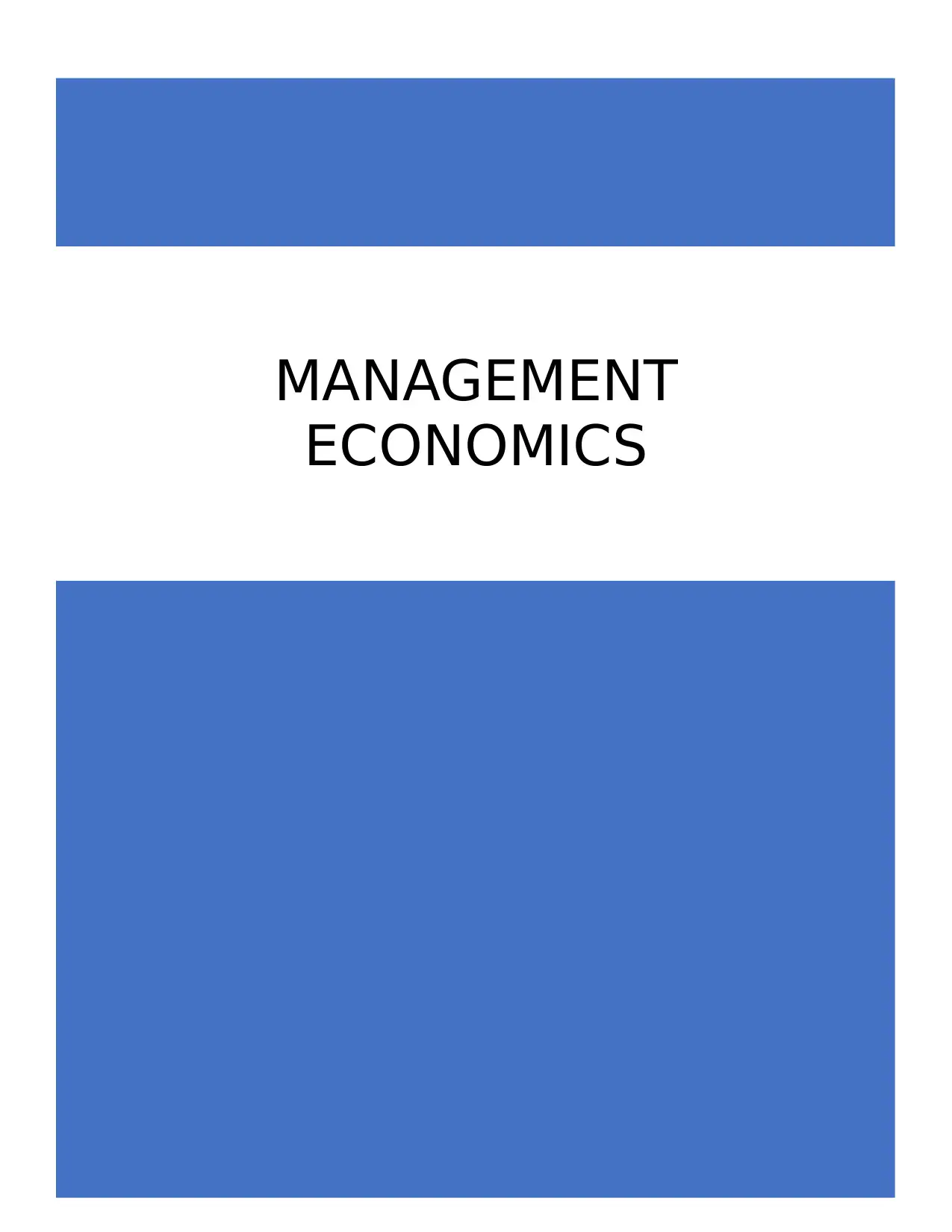
MANAGEMENT
ECONOMICS
ECONOMICS
Secure Best Marks with AI Grader
Need help grading? Try our AI Grader for instant feedback on your assignments.

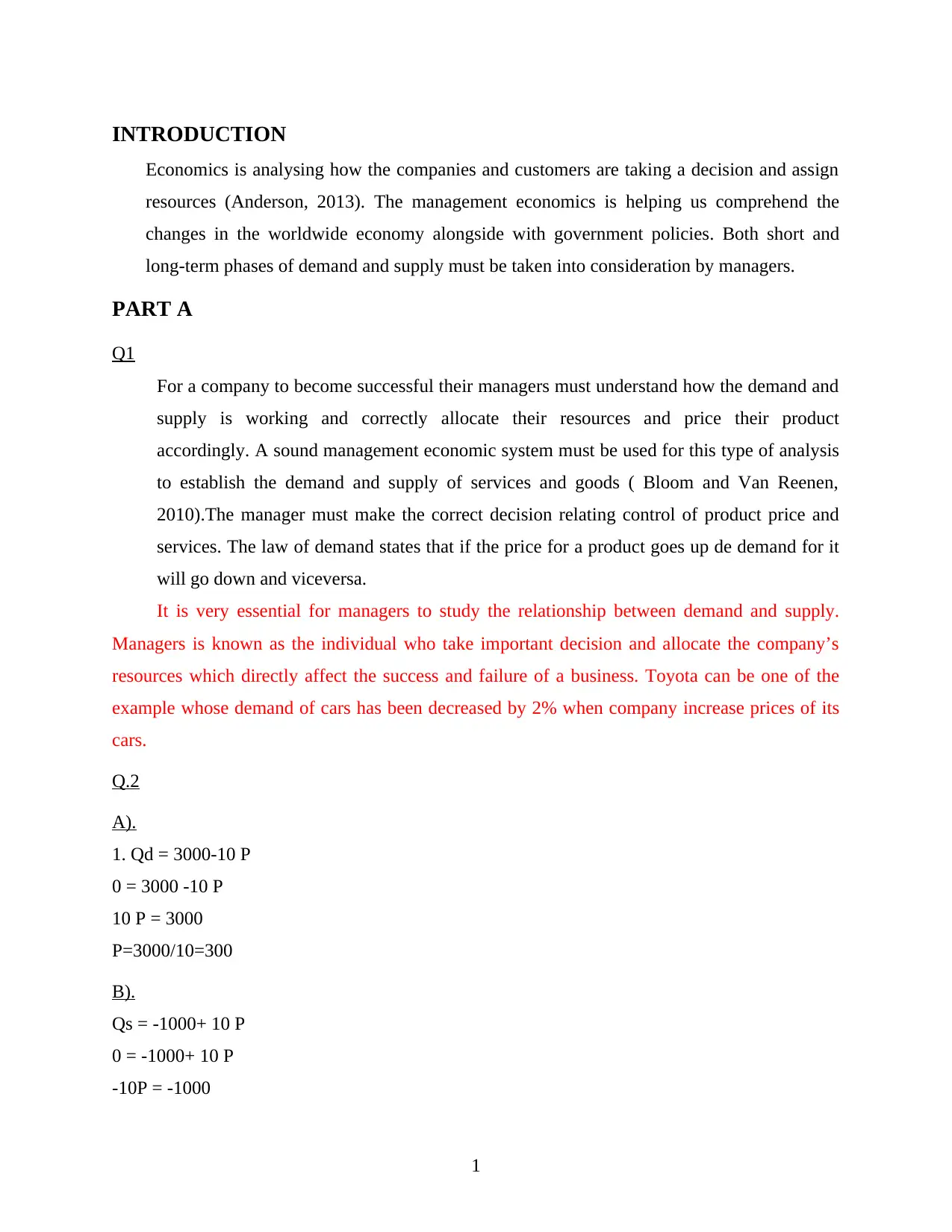
INTRODUCTION
Economics is analysing how the companies and customers are taking a decision and assign
resources (Anderson, 2013). The management economics is helping us comprehend the
changes in the worldwide economy alongside with government policies. Both short and
long-term phases of demand and supply must be taken into consideration by managers.
PART A
Q1
For a company to become successful their managers must understand how the demand and
supply is working and correctly allocate their resources and price their product
accordingly. A sound management economic system must be used for this type of analysis
to establish the demand and supply of services and goods ( Bloom and Van Reenen,
2010).The manager must make the correct decision relating control of product price and
services. The law of demand states that if the price for a product goes up de demand for it
will go down and viceversa.
It is very essential for managers to study the relationship between demand and supply.
Managers is known as the individual who take important decision and allocate the company’s
resources which directly affect the success and failure of a business. Toyota can be one of the
example whose demand of cars has been decreased by 2% when company increase prices of its
cars.
Q.2
A).
1. Qd = 3000-10 P
0 = 3000 -10 P
10 P = 3000
P=3000/10=300
B).
Qs = -1000+ 10 P
0 = -1000+ 10 P
-10P = -1000
1
Economics is analysing how the companies and customers are taking a decision and assign
resources (Anderson, 2013). The management economics is helping us comprehend the
changes in the worldwide economy alongside with government policies. Both short and
long-term phases of demand and supply must be taken into consideration by managers.
PART A
Q1
For a company to become successful their managers must understand how the demand and
supply is working and correctly allocate their resources and price their product
accordingly. A sound management economic system must be used for this type of analysis
to establish the demand and supply of services and goods ( Bloom and Van Reenen,
2010).The manager must make the correct decision relating control of product price and
services. The law of demand states that if the price for a product goes up de demand for it
will go down and viceversa.
It is very essential for managers to study the relationship between demand and supply.
Managers is known as the individual who take important decision and allocate the company’s
resources which directly affect the success and failure of a business. Toyota can be one of the
example whose demand of cars has been decreased by 2% when company increase prices of its
cars.
Q.2
A).
1. Qd = 3000-10 P
0 = 3000 -10 P
10 P = 3000
P=3000/10=300
B).
Qs = -1000+ 10 P
0 = -1000+ 10 P
-10P = -1000
1
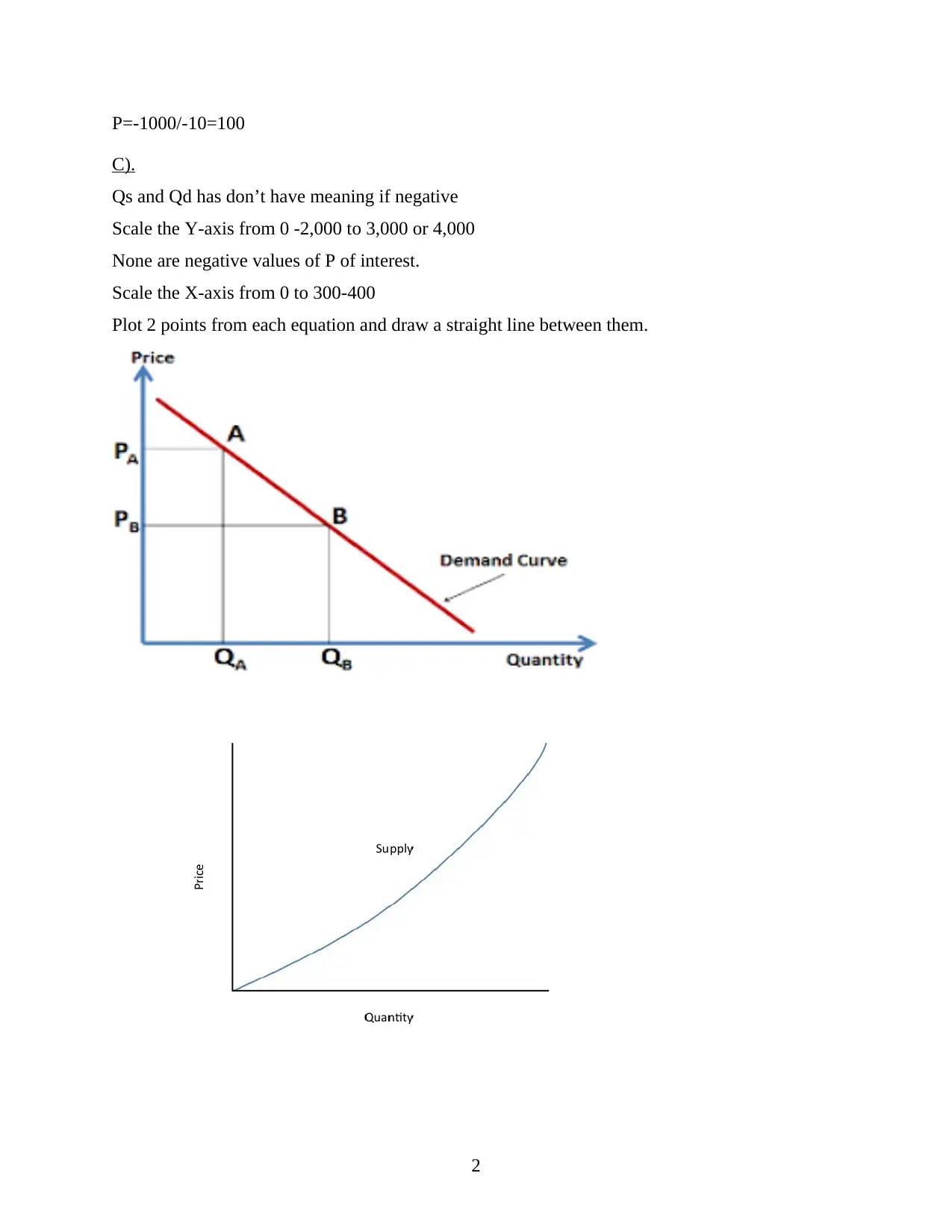
P=-1000/-10=100
C).
Qs and Qd has don’t have meaning if negative
Scale the Y-axis from 0 -2,000 to 3,000 or 4,000
None are negative values of P of interest.
Scale the X-axis from 0 to 300-400
Plot 2 points from each equation and draw a straight line between them.
2
C).
Qs and Qd has don’t have meaning if negative
Scale the Y-axis from 0 -2,000 to 3,000 or 4,000
None are negative values of P of interest.
Scale the X-axis from 0 to 300-400
Plot 2 points from each equation and draw a straight line between them.
2
Paraphrase This Document
Need a fresh take? Get an instant paraphrase of this document with our AI Paraphraser

D).
Equilibrium price output level:
Qd = Qs
3000 - 10P = -1000 + 10P
4000 = 20P
P = 200
Qd = Qc = 3000 - 2000 = 1000
E).
Supply will enhance to meet the demand.
New equilibrium point:
Qd = Qs
3500 - 10P = -1000 + 10P
4500 = 20P
P = 225
Qd = Qc = 3500 - 2250 = 1250
New equilibrium from new supplies:
Qd = Qs
3500 - 10P = -500 + 10P
3000 = 20P
P = 150
Qd = Qc = 3000 - 500 = 2500
3
Equilibrium price output level:
Qd = Qs
3000 - 10P = -1000 + 10P
4000 = 20P
P = 200
Qd = Qc = 3000 - 2000 = 1000
E).
Supply will enhance to meet the demand.
New equilibrium point:
Qd = Qs
3500 - 10P = -1000 + 10P
4500 = 20P
P = 225
Qd = Qc = 3500 - 2250 = 1250
New equilibrium from new supplies:
Qd = Qs
3500 - 10P = -500 + 10P
3000 = 20P
P = 150
Qd = Qc = 3000 - 500 = 2500
3
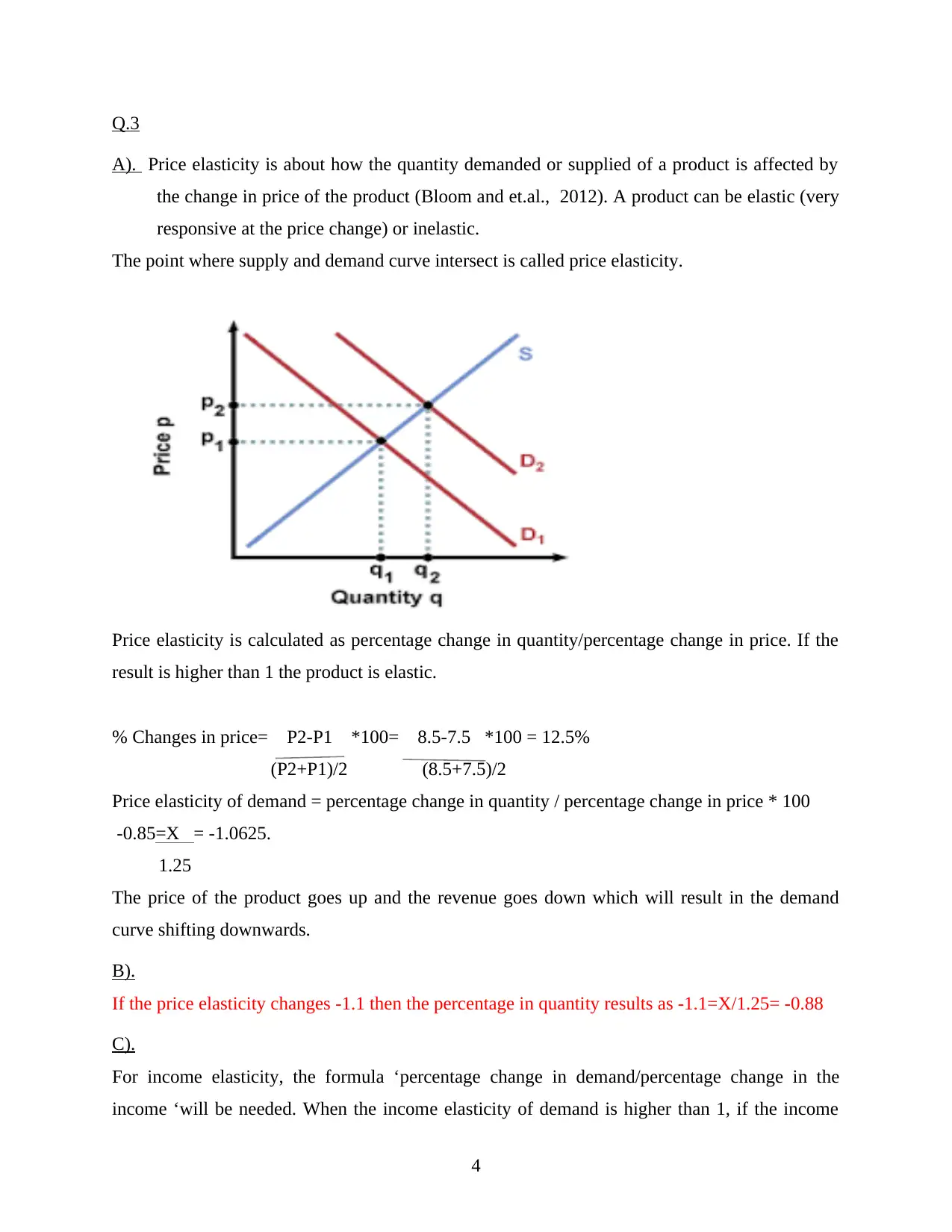
Q.3
A). Price elasticity is about how the quantity demanded or supplied of a product is affected by
the change in price of the product (Bloom and et.al., 2012). A product can be elastic (very
responsive at the price change) or inelastic.
The point where supply and demand curve intersect is called price elasticity.
Price elasticity is calculated as percentage change in quantity/percentage change in price. If the
result is higher than 1 the product is elastic.
% Changes in price= P2-P1 *100= 8.5-7.5 *100 = 12.5%
(P2+P1)/2 (8.5+7.5)/2
Price elasticity of demand = percentage change in quantity / percentage change in price * 100
-0.85=X = -1.0625.
1.25
The price of the product goes up and the revenue goes down which will result in the demand
curve shifting downwards.
B).
If the price elasticity changes -1.1 then the percentage in quantity results as -1.1=X/1.25= -0.88
C).
For income elasticity, the formula ‘percentage change in demand/percentage change in the
income ‘will be needed. When the income elasticity of demand is higher than 1, if the income
4
A). Price elasticity is about how the quantity demanded or supplied of a product is affected by
the change in price of the product (Bloom and et.al., 2012). A product can be elastic (very
responsive at the price change) or inelastic.
The point where supply and demand curve intersect is called price elasticity.
Price elasticity is calculated as percentage change in quantity/percentage change in price. If the
result is higher than 1 the product is elastic.
% Changes in price= P2-P1 *100= 8.5-7.5 *100 = 12.5%
(P2+P1)/2 (8.5+7.5)/2
Price elasticity of demand = percentage change in quantity / percentage change in price * 100
-0.85=X = -1.0625.
1.25
The price of the product goes up and the revenue goes down which will result in the demand
curve shifting downwards.
B).
If the price elasticity changes -1.1 then the percentage in quantity results as -1.1=X/1.25= -0.88
C).
For income elasticity, the formula ‘percentage change in demand/percentage change in the
income ‘will be needed. When the income elasticity of demand is higher than 1, if the income
4
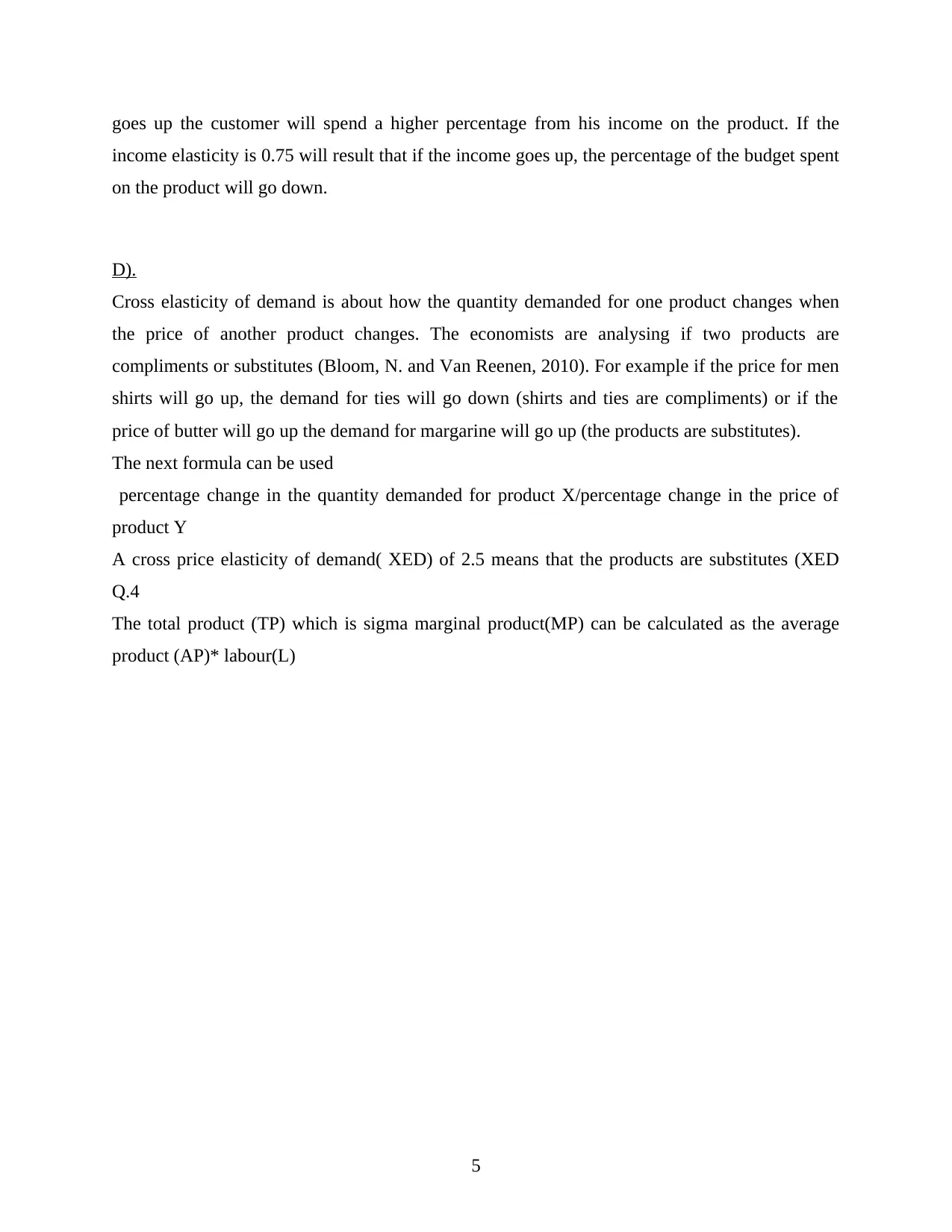
goes up the customer will spend a higher percentage from his income on the product. If the
income elasticity is 0.75 will result that if the income goes up, the percentage of the budget spent
on the product will go down.
D).
Cross elasticity of demand is about how the quantity demanded for one product changes when
the price of another product changes. The economists are analysing if two products are
compliments or substitutes (Bloom, N. and Van Reenen, 2010). For example if the price for men
shirts will go up, the demand for ties will go down (shirts and ties are compliments) or if the
price of butter will go up the demand for margarine will go up (the products are substitutes).
The next formula can be used
percentage change in the quantity demanded for product X/percentage change in the price of
product Y
A cross price elasticity of demand( XED) of 2.5 means that the products are substitutes (XED
Q.4
The total product (TP) which is sigma marginal product(MP) can be calculated as the average
product (AP)* labour(L)
5
income elasticity is 0.75 will result that if the income goes up, the percentage of the budget spent
on the product will go down.
D).
Cross elasticity of demand is about how the quantity demanded for one product changes when
the price of another product changes. The economists are analysing if two products are
compliments or substitutes (Bloom, N. and Van Reenen, 2010). For example if the price for men
shirts will go up, the demand for ties will go down (shirts and ties are compliments) or if the
price of butter will go up the demand for margarine will go up (the products are substitutes).
The next formula can be used
percentage change in the quantity demanded for product X/percentage change in the price of
product Y
A cross price elasticity of demand( XED) of 2.5 means that the products are substitutes (XED
Q.4
The total product (TP) which is sigma marginal product(MP) can be calculated as the average
product (AP)* labour(L)
5
Secure Best Marks with AI Grader
Need help grading? Try our AI Grader for instant feedback on your assignments.
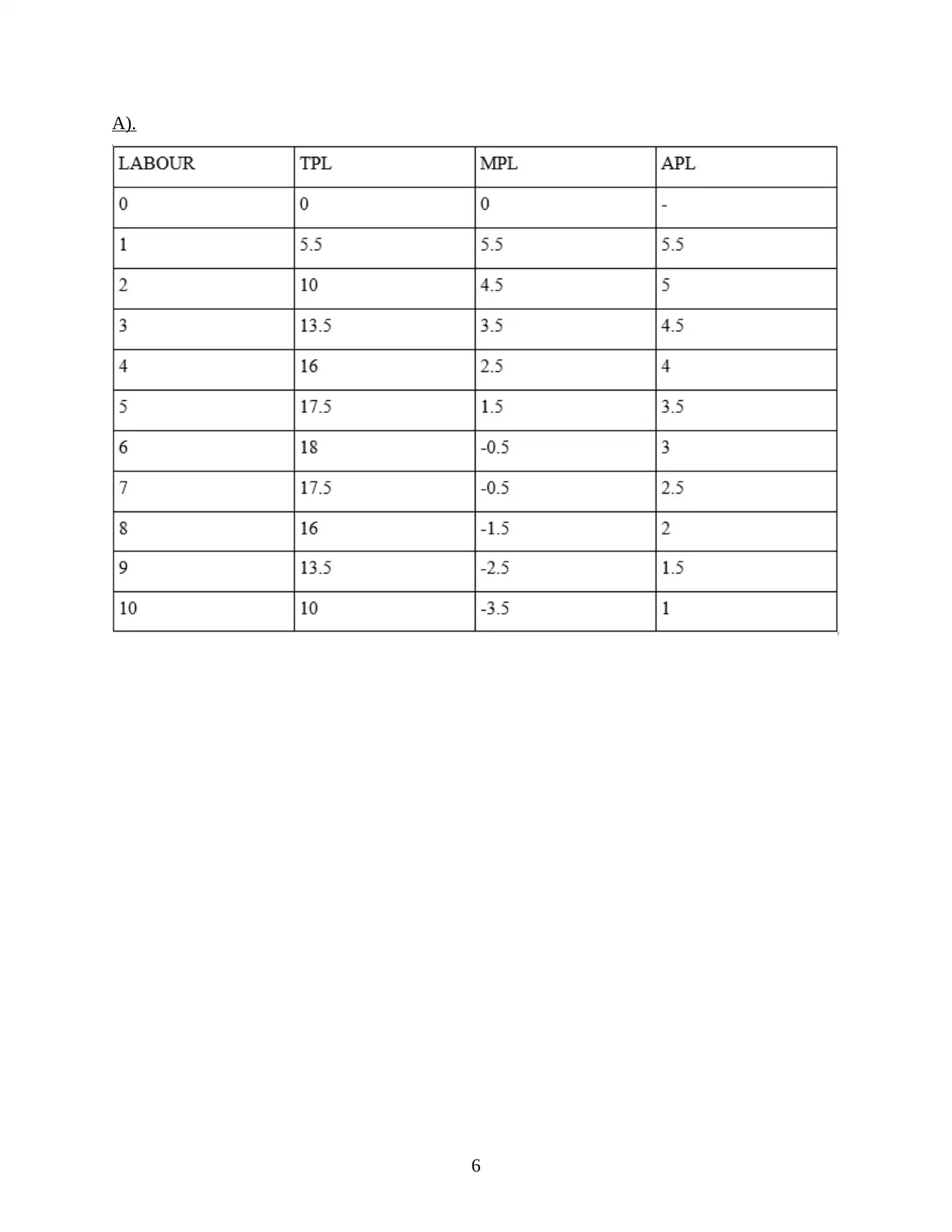
A).
6
6
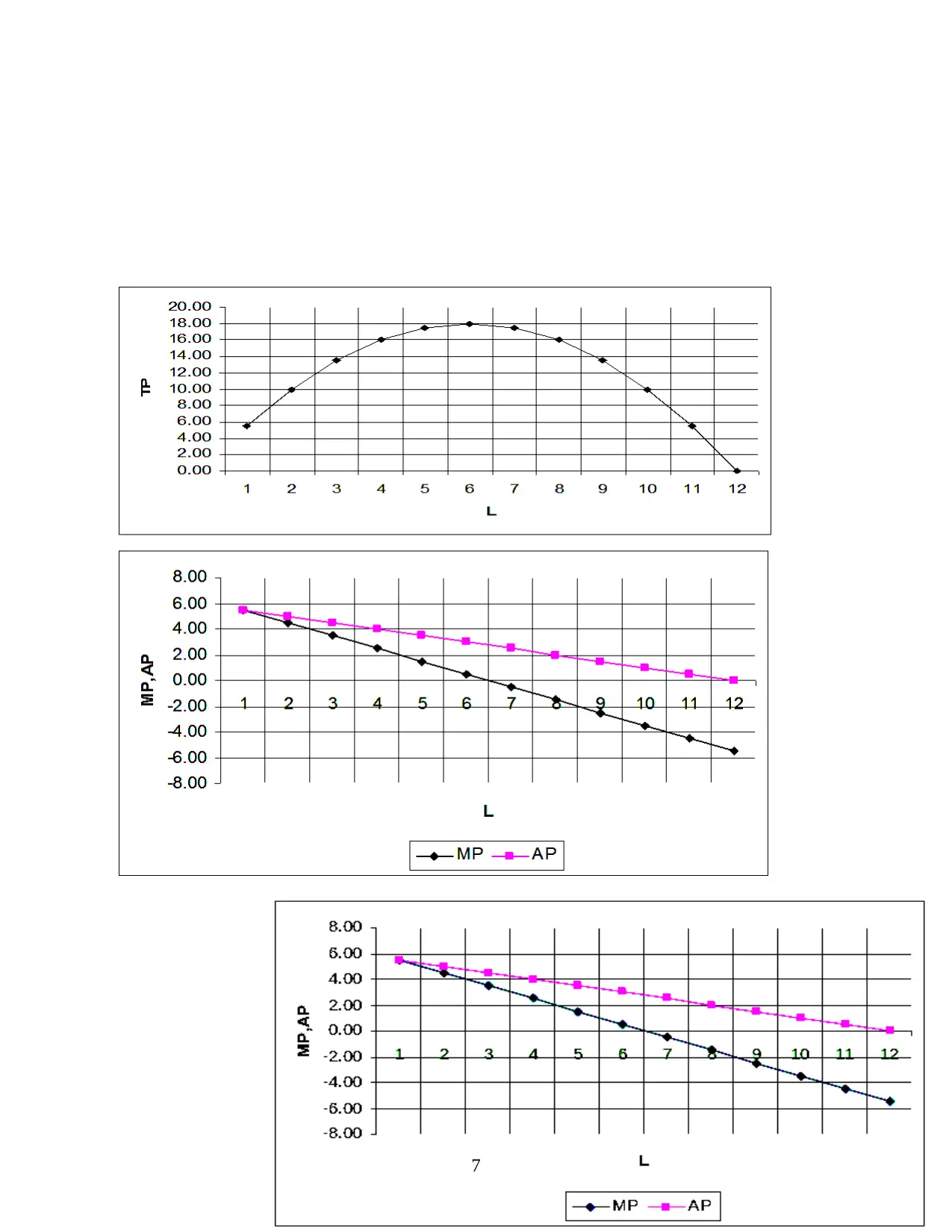
7

B).
Schedule showing the total and marginal revenue product and the wage/hour.
5*(6-L)=6
L=24/5=4.8
Can be observed that for £6/hour labour price the minimum number of employees must be 5 to
achieve the required efficiency.
8
Schedule showing the total and marginal revenue product and the wage/hour.
5*(6-L)=6
L=24/5=4.8
Can be observed that for £6/hour labour price the minimum number of employees must be 5 to
achieve the required efficiency.
8
Paraphrase This Document
Need a fresh take? Get an instant paraphrase of this document with our AI Paraphraser
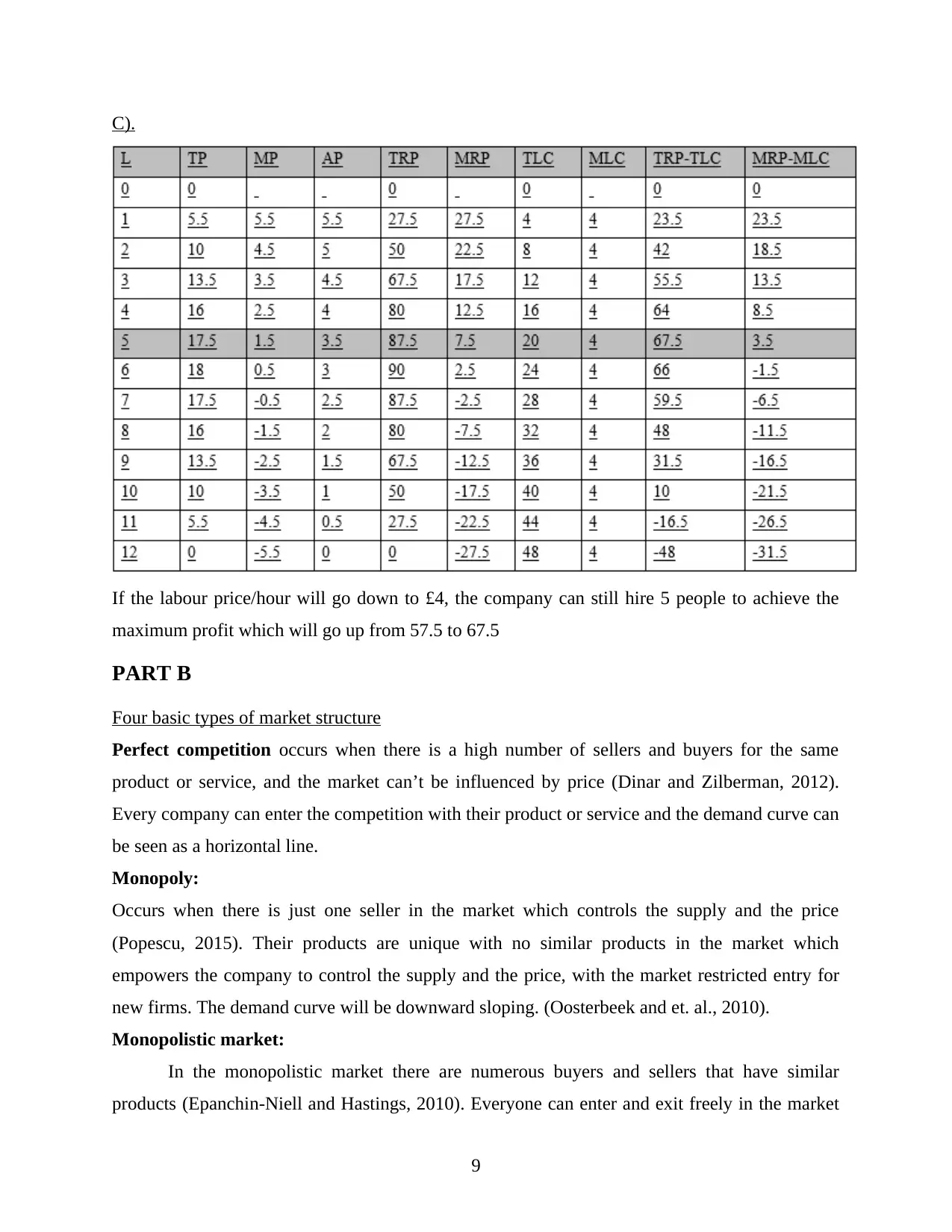
C).
If the labour price/hour will go down to £4, the company can still hire 5 people to achieve the
maximum profit which will go up from 57.5 to 67.5
PART B
Four basic types of market structure
Perfect competition occurs when there is a high number of sellers and buyers for the same
product or service, and the market can’t be influenced by price (Dinar and Zilberman, 2012).
Every company can enter the competition with their product or service and the demand curve can
be seen as a horizontal line.
Monopoly:
Occurs when there is just one seller in the market which controls the supply and the price
(Popescu, 2015). Their products are unique with no similar products in the market which
empowers the company to control the supply and the price, with the market restricted entry for
new firms. The demand curve will be downward sloping. (Oosterbeek and et. al., 2010).
Monopolistic market:
In the monopolistic market there are numerous buyers and sellers that have similar
products (Epanchin‐Niell and Hastings, 2010). Everyone can enter and exit freely in the market
9
If the labour price/hour will go down to £4, the company can still hire 5 people to achieve the
maximum profit which will go up from 57.5 to 67.5
PART B
Four basic types of market structure
Perfect competition occurs when there is a high number of sellers and buyers for the same
product or service, and the market can’t be influenced by price (Dinar and Zilberman, 2012).
Every company can enter the competition with their product or service and the demand curve can
be seen as a horizontal line.
Monopoly:
Occurs when there is just one seller in the market which controls the supply and the price
(Popescu, 2015). Their products are unique with no similar products in the market which
empowers the company to control the supply and the price, with the market restricted entry for
new firms. The demand curve will be downward sloping. (Oosterbeek and et. al., 2010).
Monopolistic market:
In the monopolistic market there are numerous buyers and sellers that have similar
products (Epanchin‐Niell and Hastings, 2010). Everyone can enter and exit freely in the market
9
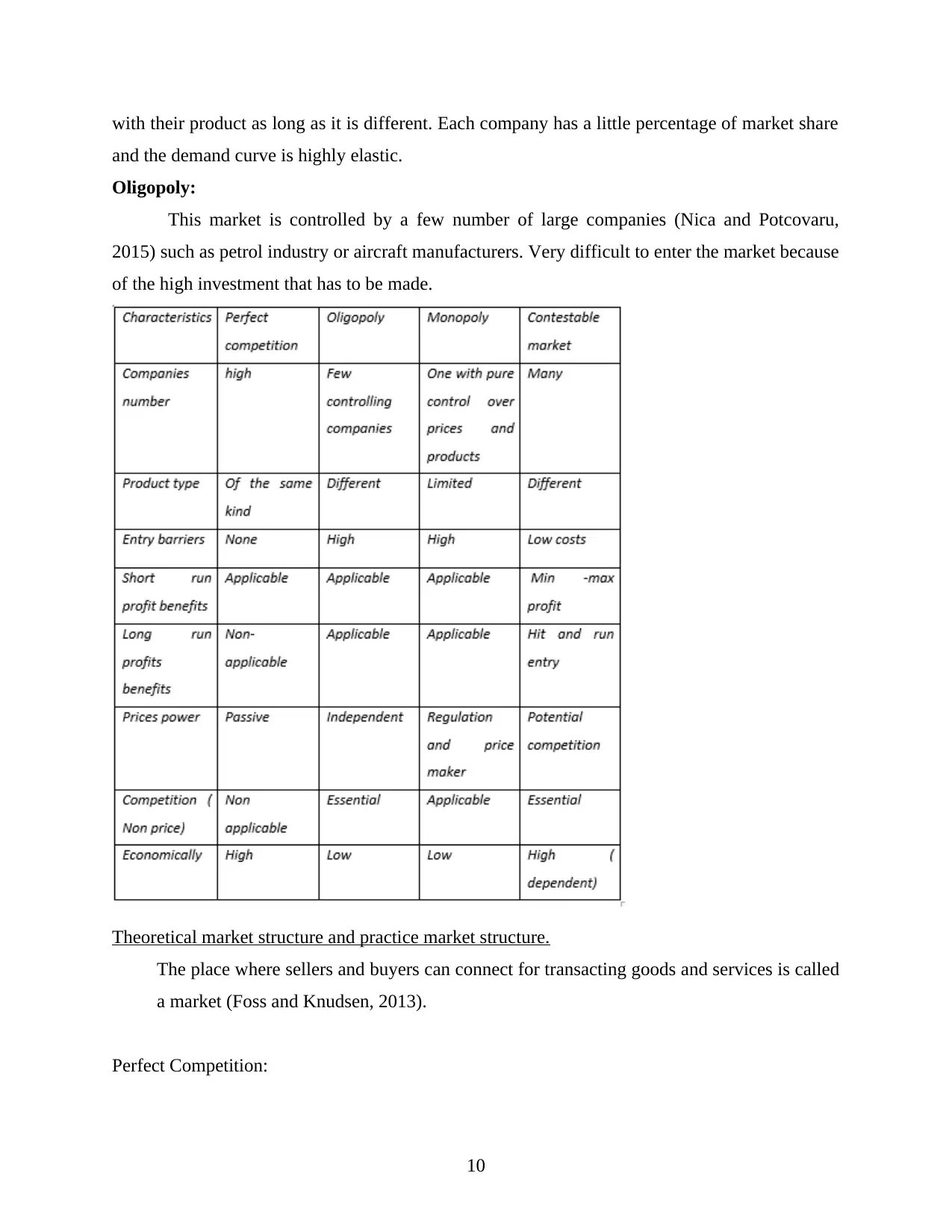
with their product as long as it is different. Each company has a little percentage of market share
and the demand curve is highly elastic.
Oligopoly:
This market is controlled by a few number of large companies (Nica and Potcovaru,
2015) such as petrol industry or aircraft manufacturers. Very difficult to enter the market because
of the high investment that has to be made.
Theoretical market structure and practice market structure.
The place where sellers and buyers can connect for transacting goods and services is called
a market (Foss and Knudsen, 2013).
Perfect Competition:
10
and the demand curve is highly elastic.
Oligopoly:
This market is controlled by a few number of large companies (Nica and Potcovaru,
2015) such as petrol industry or aircraft manufacturers. Very difficult to enter the market because
of the high investment that has to be made.
Theoretical market structure and practice market structure.
The place where sellers and buyers can connect for transacting goods and services is called
a market (Foss and Knudsen, 2013).
Perfect Competition:
10

A theoretical construct which is viewed as a benchmark against the other market
structures. With numerous sellers of homogenous products, no one can influence the price, which
is determined by the equilibrium between de mand and supply. Although perfect competition
does not exist in the real life, a close resemble can be seen in agricultural market where there are
high number of farmers which are selling the same product and a high number of buyers.
Monopolistic competition:
Numerous companies that are providing similar products or services which are
differentiated by brand or quality (Neubauer and et. al., 2013). Although the products are similar
they are not viewed as identical by the buyers so they are not perfect substitutes.
Monopoly market:
Monopoly market can be found when is only one seller for a certain product or service. The
company will serve the entire market, with no competition to influence them and can establish
high prices. Examples of monopoly can be the gas and electricity companies.
Oligopoly:
The market dominated by a few number of companies, it is similar to the monopoly but is
differentiated by having both theoretical and practice constructs (Kamien and Schwartz, 2012).
For example if a company is increasing the price, the buyer will switch to the other company.
This can be observed at the telephone and internet providers.
Rail industry in Britain
All market structures try to achieve the maximum profit. In the perfect market competition the
company’s goal is to keep the profit high while the price is reduced by the high number of
competitors (Rafols and et.al., 2012). In the case of monopolies, a good infrastructure is needed
and the distribution costs are high (Kaufman, 2010). This monopoly market can be seen in the
rail industry, which needs to develop an expensive infrastructure. The UK government must
make sure that monopolies are kept under control .
In order to build a railway system a high amount of investment must be made in order to get a
share of the market. This is preventing new competitors entering the market with a rival network,
leaving Britain Rail to own the monopoly.
11
structures. With numerous sellers of homogenous products, no one can influence the price, which
is determined by the equilibrium between de mand and supply. Although perfect competition
does not exist in the real life, a close resemble can be seen in agricultural market where there are
high number of farmers which are selling the same product and a high number of buyers.
Monopolistic competition:
Numerous companies that are providing similar products or services which are
differentiated by brand or quality (Neubauer and et. al., 2013). Although the products are similar
they are not viewed as identical by the buyers so they are not perfect substitutes.
Monopoly market:
Monopoly market can be found when is only one seller for a certain product or service. The
company will serve the entire market, with no competition to influence them and can establish
high prices. Examples of monopoly can be the gas and electricity companies.
Oligopoly:
The market dominated by a few number of companies, it is similar to the monopoly but is
differentiated by having both theoretical and practice constructs (Kamien and Schwartz, 2012).
For example if a company is increasing the price, the buyer will switch to the other company.
This can be observed at the telephone and internet providers.
Rail industry in Britain
All market structures try to achieve the maximum profit. In the perfect market competition the
company’s goal is to keep the profit high while the price is reduced by the high number of
competitors (Rafols and et.al., 2012). In the case of monopolies, a good infrastructure is needed
and the distribution costs are high (Kaufman, 2010). This monopoly market can be seen in the
rail industry, which needs to develop an expensive infrastructure. The UK government must
make sure that monopolies are kept under control .
In order to build a railway system a high amount of investment must be made in order to get a
share of the market. This is preventing new competitors entering the market with a rival network,
leaving Britain Rail to own the monopoly.
11
Secure Best Marks with AI Grader
Need help grading? Try our AI Grader for instant feedback on your assignments.
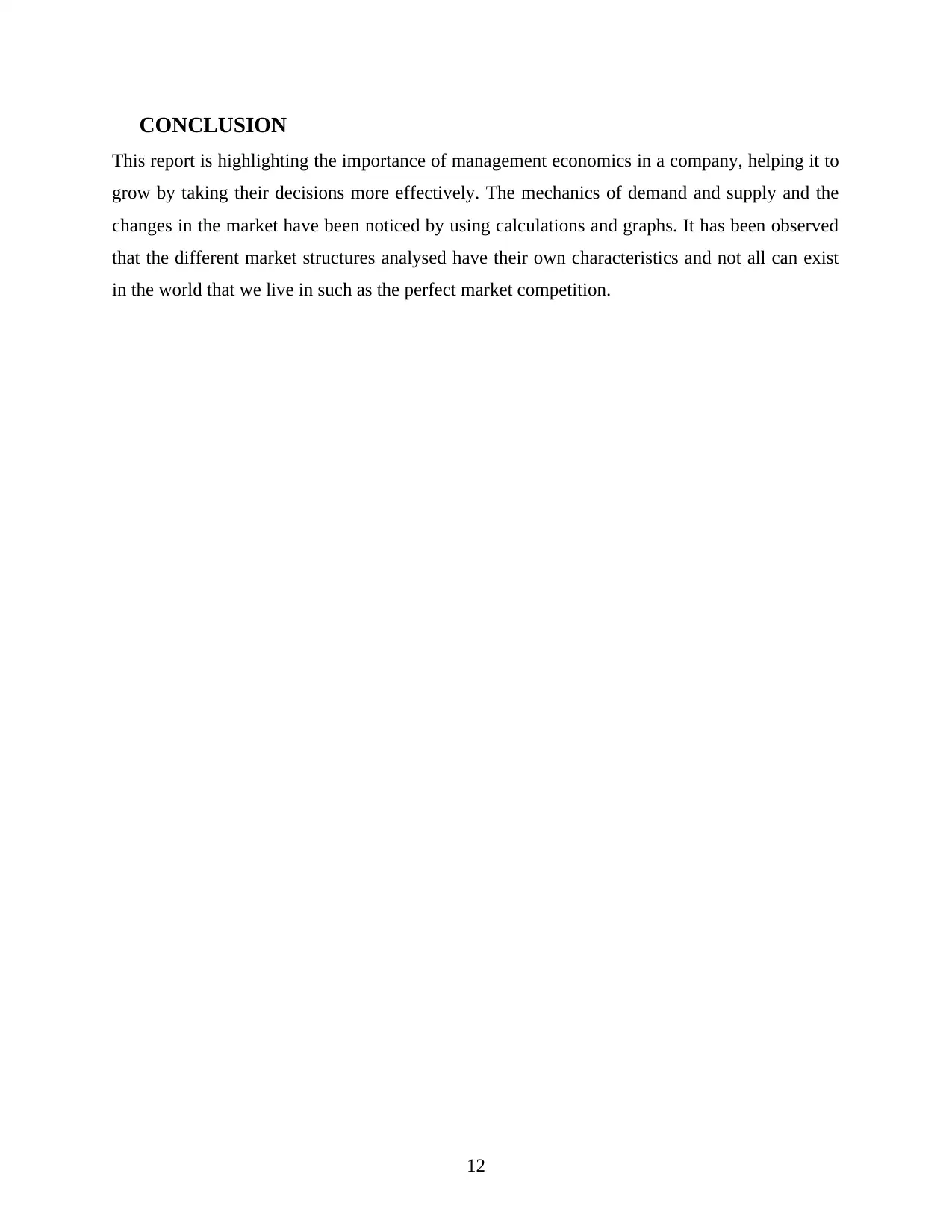
CONCLUSION
This report is highlighting the importance of management economics in a company, helping it to
grow by taking their decisions more effectively. The mechanics of demand and supply and the
changes in the market have been noticed by using calculations and graphs. It has been observed
that the different market structures analysed have their own characteristics and not all can exist
in the world that we live in such as the perfect market competition.
12
This report is highlighting the importance of management economics in a company, helping it to
grow by taking their decisions more effectively. The mechanics of demand and supply and the
changes in the market have been noticed by using calculations and graphs. It has been observed
that the different market structures analysed have their own characteristics and not all can exist
in the world that we live in such as the perfect market competition.
12
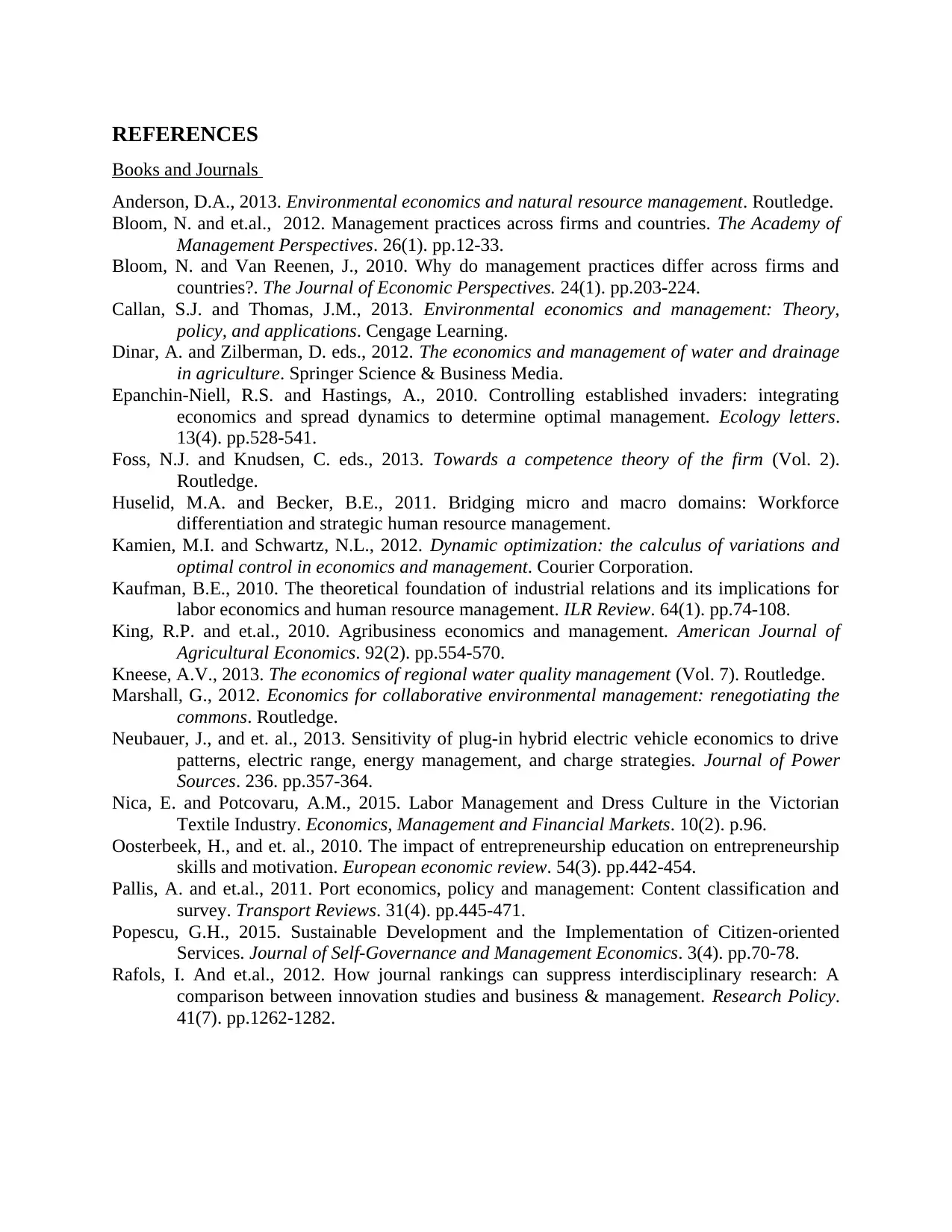
REFERENCES
Books and Journals
Anderson, D.A., 2013. Environmental economics and natural resource management. Routledge.
Bloom, N. and et.al., 2012. Management practices across firms and countries. The Academy of
Management Perspectives. 26(1). pp.12-33.
Bloom, N. and Van Reenen, J., 2010. Why do management practices differ across firms and
countries?. The Journal of Economic Perspectives. 24(1). pp.203-224.
Callan, S.J. and Thomas, J.M., 2013. Environmental economics and management: Theory,
policy, and applications. Cengage Learning.
Dinar, A. and Zilberman, D. eds., 2012. The economics and management of water and drainage
in agriculture. Springer Science & Business Media.
Epanchin‐Niell, R.S. and Hastings, A., 2010. Controlling established invaders: integrating
economics and spread dynamics to determine optimal management. Ecology letters.
13(4). pp.528-541.
Foss, N.J. and Knudsen, C. eds., 2013. Towards a competence theory of the firm (Vol. 2).
Routledge.
Huselid, M.A. and Becker, B.E., 2011. Bridging micro and macro domains: Workforce
differentiation and strategic human resource management.
Kamien, M.I. and Schwartz, N.L., 2012. Dynamic optimization: the calculus of variations and
optimal control in economics and management. Courier Corporation.
Kaufman, B.E., 2010. The theoretical foundation of industrial relations and its implications for
labor economics and human resource management. ILR Review. 64(1). pp.74-108.
King, R.P. and et.al., 2010. Agribusiness economics and management. American Journal of
Agricultural Economics. 92(2). pp.554-570.
Kneese, A.V., 2013. The economics of regional water quality management (Vol. 7). Routledge.
Marshall, G., 2012. Economics for collaborative environmental management: renegotiating the
commons. Routledge.
Neubauer, J., and et. al., 2013. Sensitivity of plug-in hybrid electric vehicle economics to drive
patterns, electric range, energy management, and charge strategies. Journal of Power
Sources. 236. pp.357-364.
Nica, E. and Potcovaru, A.M., 2015. Labor Management and Dress Culture in the Victorian
Textile Industry. Economics, Management and Financial Markets. 10(2). p.96.
Oosterbeek, H., and et. al., 2010. The impact of entrepreneurship education on entrepreneurship
skills and motivation. European economic review. 54(3). pp.442-454.
Pallis, A. and et.al., 2011. Port economics, policy and management: Content classification and
survey. Transport Reviews. 31(4). pp.445-471.
Popescu, G.H., 2015. Sustainable Development and the Implementation of Citizen-oriented
Services. Journal of Self-Governance and Management Economics. 3(4). pp.70-78.
Rafols, I. And et.al., 2012. How journal rankings can suppress interdisciplinary research: A
comparison between innovation studies and business & management. Research Policy.
41(7). pp.1262-1282.
Books and Journals
Anderson, D.A., 2013. Environmental economics and natural resource management. Routledge.
Bloom, N. and et.al., 2012. Management practices across firms and countries. The Academy of
Management Perspectives. 26(1). pp.12-33.
Bloom, N. and Van Reenen, J., 2010. Why do management practices differ across firms and
countries?. The Journal of Economic Perspectives. 24(1). pp.203-224.
Callan, S.J. and Thomas, J.M., 2013. Environmental economics and management: Theory,
policy, and applications. Cengage Learning.
Dinar, A. and Zilberman, D. eds., 2012. The economics and management of water and drainage
in agriculture. Springer Science & Business Media.
Epanchin‐Niell, R.S. and Hastings, A., 2010. Controlling established invaders: integrating
economics and spread dynamics to determine optimal management. Ecology letters.
13(4). pp.528-541.
Foss, N.J. and Knudsen, C. eds., 2013. Towards a competence theory of the firm (Vol. 2).
Routledge.
Huselid, M.A. and Becker, B.E., 2011. Bridging micro and macro domains: Workforce
differentiation and strategic human resource management.
Kamien, M.I. and Schwartz, N.L., 2012. Dynamic optimization: the calculus of variations and
optimal control in economics and management. Courier Corporation.
Kaufman, B.E., 2010. The theoretical foundation of industrial relations and its implications for
labor economics and human resource management. ILR Review. 64(1). pp.74-108.
King, R.P. and et.al., 2010. Agribusiness economics and management. American Journal of
Agricultural Economics. 92(2). pp.554-570.
Kneese, A.V., 2013. The economics of regional water quality management (Vol. 7). Routledge.
Marshall, G., 2012. Economics for collaborative environmental management: renegotiating the
commons. Routledge.
Neubauer, J., and et. al., 2013. Sensitivity of plug-in hybrid electric vehicle economics to drive
patterns, electric range, energy management, and charge strategies. Journal of Power
Sources. 236. pp.357-364.
Nica, E. and Potcovaru, A.M., 2015. Labor Management and Dress Culture in the Victorian
Textile Industry. Economics, Management and Financial Markets. 10(2). p.96.
Oosterbeek, H., and et. al., 2010. The impact of entrepreneurship education on entrepreneurship
skills and motivation. European economic review. 54(3). pp.442-454.
Pallis, A. and et.al., 2011. Port economics, policy and management: Content classification and
survey. Transport Reviews. 31(4). pp.445-471.
Popescu, G.H., 2015. Sustainable Development and the Implementation of Citizen-oriented
Services. Journal of Self-Governance and Management Economics. 3(4). pp.70-78.
Rafols, I. And et.al., 2012. How journal rankings can suppress interdisciplinary research: A
comparison between innovation studies and business & management. Research Policy.
41(7). pp.1262-1282.

Sarkis, J., and et. al., 2011. An organizational theoretic review of green supply chain
management literature. International Journal of Production Economics. 130(1). pp.1-15.
Schor, J., 2016. DEBATING THE SHARING ECONOMY. Journal of Self-Governance &
Management Economics, 4(3).
Snyder, M. and Deaux, K., 2012. Personality and social psychology. In The Oxford handbook of
personality and social psychology.
Vytelingum, P. and et.al., 2010, May. Agent-based micro-storage management for the smart grid.
In Proceedings of the 9th International Conference on Autonomous Agents and
Multiagent Systems: Volume 1-Volume 1 (pp. 39-46). International Foundation for
Autonomous Agents and Multiagent Systems.
Wever, M. and et.al., 2010. Alignment between chain quality management and chain governance
in EU pork supply chains: A Transaction-Cost-Economics perspective. Meat science.
84(2). pp.228-237.
Wiklund, J. and et.al., 2011. The future of entrepreneurship research. Entrepreneurship Theory
and Practice. 35(1). pp.1-9.
Online
Rail franchises are monopolies that need scrapping . 2017. [Online]. Available through:
<http://www.telegraph.co.uk/news/uknews/road-and-rail-transport/12077462/Rail-
franchises-are-monopolies-that-need-scrapping.html>. [Accessed on 24th July 2017].
2
management literature. International Journal of Production Economics. 130(1). pp.1-15.
Schor, J., 2016. DEBATING THE SHARING ECONOMY. Journal of Self-Governance &
Management Economics, 4(3).
Snyder, M. and Deaux, K., 2012. Personality and social psychology. In The Oxford handbook of
personality and social psychology.
Vytelingum, P. and et.al., 2010, May. Agent-based micro-storage management for the smart grid.
In Proceedings of the 9th International Conference on Autonomous Agents and
Multiagent Systems: Volume 1-Volume 1 (pp. 39-46). International Foundation for
Autonomous Agents and Multiagent Systems.
Wever, M. and et.al., 2010. Alignment between chain quality management and chain governance
in EU pork supply chains: A Transaction-Cost-Economics perspective. Meat science.
84(2). pp.228-237.
Wiklund, J. and et.al., 2011. The future of entrepreneurship research. Entrepreneurship Theory
and Practice. 35(1). pp.1-9.
Online
Rail franchises are monopolies that need scrapping . 2017. [Online]. Available through:
<http://www.telegraph.co.uk/news/uknews/road-and-rail-transport/12077462/Rail-
franchises-are-monopolies-that-need-scrapping.html>. [Accessed on 24th July 2017].
2
1 out of 16
Related Documents
Your All-in-One AI-Powered Toolkit for Academic Success.
+13062052269
info@desklib.com
Available 24*7 on WhatsApp / Email
![[object Object]](/_next/static/media/star-bottom.7253800d.svg)
Unlock your academic potential
© 2024 | Zucol Services PVT LTD | All rights reserved.





